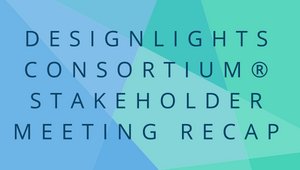The DesignLights Consortium® Stakeholder meeting was held earlier this month at Boston Park Plaza in Boston, Massachusetts - the hometown of the DesignLights Consortium! Networking kicked-off this event and was a prominent theme during all three days of the event. The main focus was on on efforts to help utilities with running successful lighting efficiency programs and the tools they need to do so, challenges of the latest technology and how the industry is addressing them, and gathering stakeholder input. There were a lot of networking, learning, and collaborating activities on how to bring LED tech into buildings across the world.
 One of the most illuminating presentations was "The Future of Lighting Efficiency." Dan Mellinger, a Senior Consultant at Energy Futures Group spoke about characterizing where utility savings are going to come from for lighting and beyond. He also debunked some myths. A big one is that lighting incentives are coming to an end. While this may be true for residential programs, it is completely false for commercial and industrial programs. LED lighting upgrades are still in the growth phase and NLCs (networked lighting controls) will help extend this. One of the conclusions from his presentation was, “Residential utility programs may be facing a cliff, but C&I utility programs will be riding a wave of savings for many years.1” The residential LED upgrade lighting market is made up of almost 90% screw base bulbs, while the C&I industry is made up of only 10% screw base bulbs. That leaves 90% of the lighting market for LED upgrades. “The vast majority of C&I installed inventory consists of linear lamps and fixtures, [not bulbs]. C&I product categories generally have low LED market penetration and higher savings potential.1”
One of the most illuminating presentations was "The Future of Lighting Efficiency." Dan Mellinger, a Senior Consultant at Energy Futures Group spoke about characterizing where utility savings are going to come from for lighting and beyond. He also debunked some myths. A big one is that lighting incentives are coming to an end. While this may be true for residential programs, it is completely false for commercial and industrial programs. LED lighting upgrades are still in the growth phase and NLCs (networked lighting controls) will help extend this. One of the conclusions from his presentation was, “Residential utility programs may be facing a cliff, but C&I utility programs will be riding a wave of savings for many years.1” The residential LED upgrade lighting market is made up of almost 90% screw base bulbs, while the C&I industry is made up of only 10% screw base bulbs. That leaves 90% of the lighting market for LED upgrades. “The vast majority of C&I installed inventory consists of linear lamps and fixtures, [not bulbs]. C&I product categories generally have low LED market penetration and higher savings potential.1”
Now, let’s explore some information on how lighting may affect health for humans and animals. It is important to be mindful when upgrading or adding exterior lighting to a building, parking lot, or another commercial space because of the effects on people, plants, and animals. Extra lighting at night is not a natural phenomenon, so it’s crucial to use the minimal amount needed to light the way. Here are some questions you can ask when upgrading or adding new outdoor lighting, “What can be done to minimize the negative impact of outdoor lighting? Can it be positioned a different way? Is it possible to turn off the lights when not needed or use motion sensors for security lighting?” It’s all about what can be done to reduce the negative impacts and being energy efficient.
Lastly, horticultural lighting is proving to be a next “big thing” for lighting upgrades. Light is an actual ingredient for horticulture and is part of the growing process. Energy is almost always the most expensive part of growing and the facilities that are built consume large amounts of energy. That means there is a huge potential to upgrade all those facilities to LEDs and the new facilities that are being built can have LED lighting initially. LEDs can be tuned to adjust and improve the circumstances for growth that will enable the most efficient way to grow the product. UV (ultraviolet) LEDs, monochromatic red and blue LEDs, and many other options can deliver the full spectrum of light to mimic natural sunlight, allowing for adaptation for the various needs of all crops and for the different stages of the plant life cycle.
Quick update on DLC SSL V5.0 which is slated for 2020 and will be a major overhaul. This version will be focusing more on the quality of light and controls, and less on efficacy. Improving controls performance remains a top priority and accelerating their adoption. This is viewed as a lost opportunity because a lot of program administrators see a high proportion of lamps and luminaires installed without incorporating networked lighting controls. Several new metrics in the areas of color quality, glare, and flicker, and ways to measure application performance of listed products are also under consideration. This will be the next evolution of lighting!
MOST IMPORTANT TAKEAWAYS:
DLC V5.0 IS focusing more on the quality of light and controls and less on efficacy
Lighting programs are going to be around for a long time
Horticultural lighting is proving to be the next big thing for upgrades
NLCs are a good source of additional energy savings
1DesignLights Consortium® July 2018 Stakeholder Meeting; Presentation: “The Future of Lighting Efficiency” by Dan Mellinger, Senior Consultant, Energy Futures Group link: https://www.designlights.org/news-events/events/2018-dlc-stakeholder-meeting/agenda/
.png?width=500&name=2019%20e%20news%20spotlight%20logo%20(1).png)




